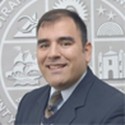By: Sean Robinson, Program Chair, Predictive Analytics World for Government
In anticipation of his upcoming conference presentation, Mining the Voter File, at Predictive Analytics World for Government, Oct 13-16, 2015, we asked Benjamin Uminsky, Executive  Assistant, Data Scientist, Los Angeles County Registrar Recorder/County Clerk’s Office, a few questions about his work in predictive analytics.
Assistant, Data Scientist, Los Angeles County Registrar Recorder/County Clerk’s Office, a few questions about his work in predictive analytics.
Q: How would you characterize your agency’s current and/or planned use of predictive analytics? What is one specific way in which predictive analytics actively drives decisions in your agency?
A: The Los Angeles County Registrar Recorder/County Clerk is already using time series forecasting to anticipate revenue changes from our real property recorder operations for future fiscal quarters and years. We are also committed to developing an applied predictive model to help our poll worker recruiters better identify likely volunteers that will show up on Election Day and serve as poll workers. Our individual recruiters have good intuitions about who to contact and are also able to get commitments from poll workers, however, a predictive model will be able to see the entire data set of responses from potential poll workers that no recruiter could see or analyze at an individual level. The model will serve to be a new tool in helping our poll worker recruiters sift through their lengthy lists of potential poll workers and help them find the right people to call for Election Day.
Q: Can you describe the challenges you face or have already overcome in establishing a data-driven environment in your agency?
A: Moving from a non-data driven management culture has been a significant challenge, one that is an ongoing journey for our Department. Part of the problem is a lack of trust that managers have in the statistical methods. The lack of trust is ultimately associated with an unfamiliarity in the methods and a fundamental lack of understanding as to how the methods work. Another large problem is moving managers out of their comfort zones. We are asking so much more of our managers when they make data-driven business. It is not enough anymore for a manager to justify a business decision with little more than intuition, limited observation of their operations, and narrow input from subordinate managers/supervisors.
Q: Can you discuss any near term goals you have for improving your agency’s use of predictive analytics?
A: We want to continue building bridges with our management teams and help them become more familiar with what a predictive analytic can do for them, without overwhelming them with the conceptual aspects of the predictive modeling process best left to the data scientists. Part of building trust with our management teams is in finding ways to communicate how a predictive model works, using intuitive explanations and reassuring managers that the predictive models are not being developed in order to replace their own judgement and intuitions but to complement them. Our Department is currently developing a crash course in data driven decision making. We hope that this training, intended for our managers, will help acclimate them and make them more comfortable with a shift to a new data driven decision making culture.
Q: Can you describe a successful result from the employment of predictive analytics in your agency, i.e., cost avoidance, funds recovered, improved efficiency, etc.
A: Our poll worker recruitment prediction model will hopefully save the Department the added costs of temp hiring and overtime spending. However, these estimations are only theoretical as we have not yet had an election that we can test the model on.
Q: What tools are you currently using to perform data analytics?
A: Our Department is now a R shop and we are able to engage in a full suite of data analytic techniques using R (web scraping, data tidying and cleaning, exploratory data analysis, data visualization, data mining, applied predictive modeling, etc.). Importantly, our Department has collaborated with a number of academic institutions to further enhance our Data Analytics program. The academic institutions that we have engaged with are accustomed to doing statistical learning projects using R and Python. The fact that we use R as well makes sharing and learning of new data analytic techniques much easier with these academic institutions.
Q: Sneak preview: Please tell us a take-away that you will provide during your talk at Predictive Analytics World for Government.
A: I think the biggest take away from my talk is how we are putting our voter and election data to good use by using both supervised and unsupervised statistical learning techniques. For those that attend the talk, they will see what kind of data our Department collects and how it can be both transformed and mined so as to extract important and interesting business insights that can enhance our service delivery.
———————
Don’t miss Benjamin’s conference presentation, Mining the Voter File on Wednesday, October 14, 2015 from 11:20 am to 12:05 pm at Predictive Analytics World for Government. Click here to register to attend.
By: Sean Robinson, Program Chair, Predictive Analytics World for Government
